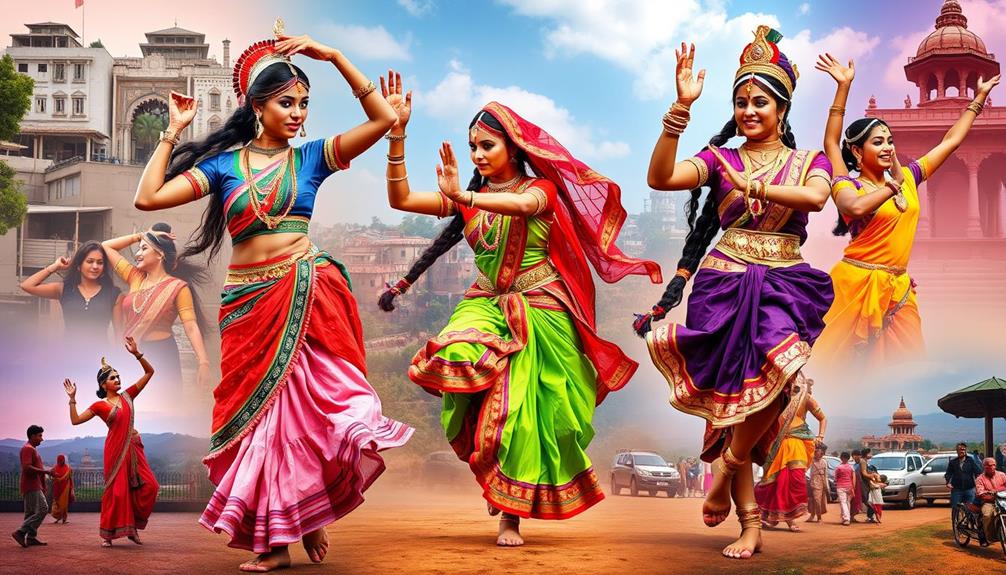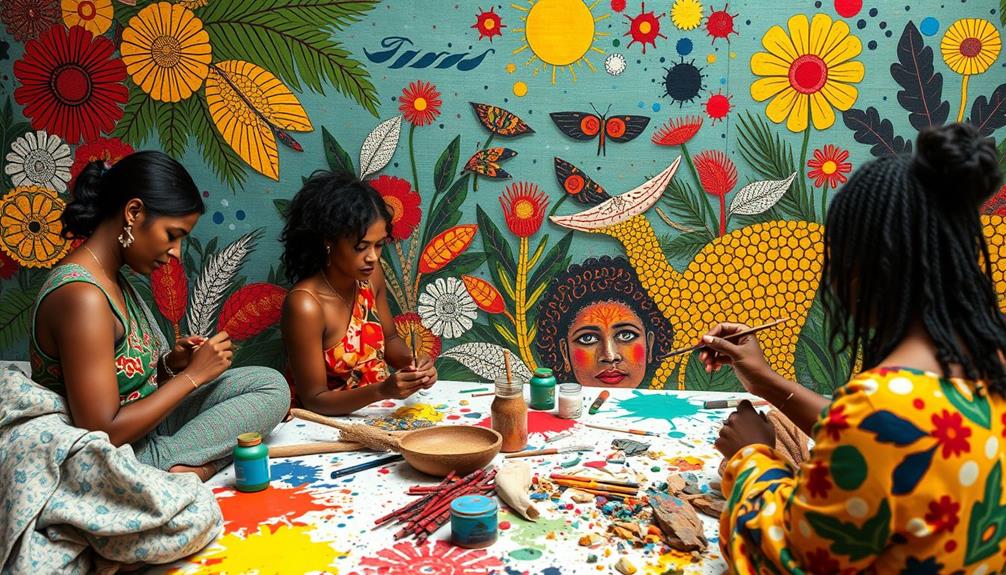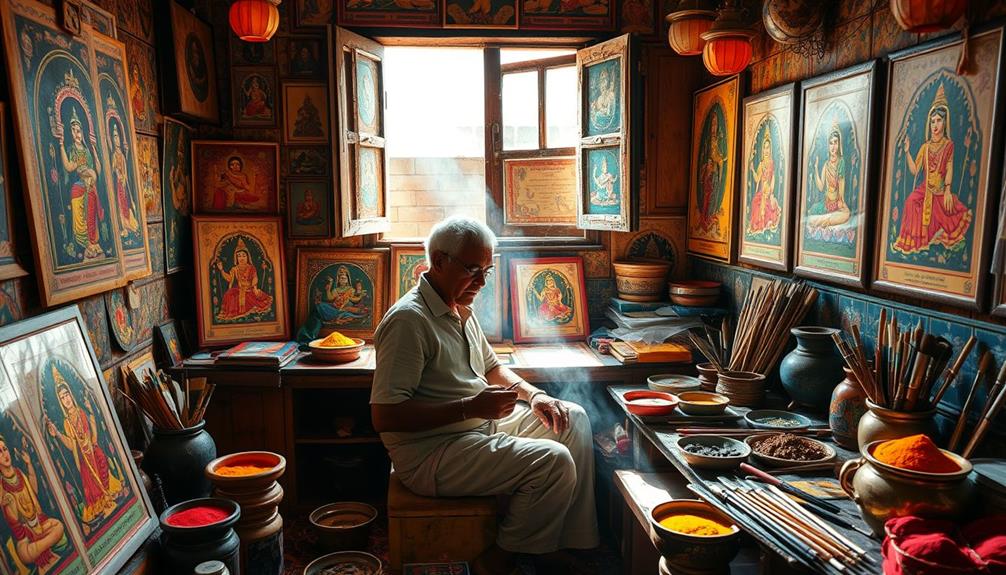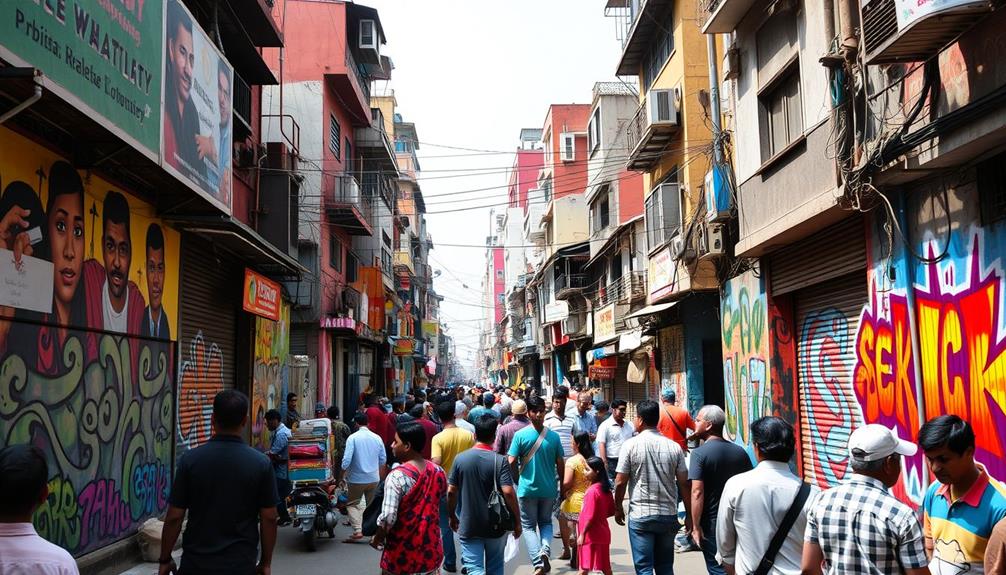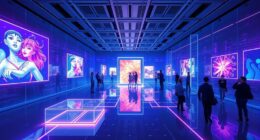You can track the evolution of performance art in India from ancient traditions like the Natya Shastra, which shaped early dance and drama, to the modern expressions pioneered by influential artists such as Nikhil Chopra and Pushpamala N. These artists explore themes of identity, gender, and environmental issues through innovative performances. The shift from observation to participation has transformed audience engagement, making performance art a crucial platform for social discourse. By integrating technology and traditional methods, these contemporary artists continuously push boundaries. Stick around to uncover the diverse paths this enchanting art form has taken over the years.
Key Takeaways
- Performance art in India has roots in the ancient Natya Shastra, influencing dance, music, and drama since the 2nd century.
- Pioneering artists like Bhupen Khakhar and Nikhil Chopra challenge traditional norms, addressing societal issues and personal identities through immersive performances.
- Themes such as identity, environmental concerns, and feminist narratives are central to contemporary performance art, provoking critical discussions among audiences.
- Audience engagement has evolved from passive observation to active participation, enhancing the relevance and impact of performance art in urban settings.
- Technological advancements and digital platforms are reshaping performance art, providing global exposure and fostering innovative, interactive experiences for artists and audiences alike.
Historical Context of Performance Art
The roots of India's performance art can be traced back to the Natya Shastra, a foundational text from the 2nd century that outlines the principles of dance, music, and drama. Understanding this historical context is essential for appreciating how traditional Indian performance art has evolved.
Through centuries, various cultural influences have woven into these art forms, integrating religious practices and storytelling as crucial components of community identity and expression. This evolution can be likened to the way various materials available in home decor influence aesthetic choices, reflecting the changing tastes and needs of society.
Traditional Indian performance art, such as Thirayattam and Jatra, often combines dramatic elements with ritualistic practices. These performances address social and community issues, reflecting the lived experiences of the people. They serve not just as entertainment but also as a means of cultural preservation and social commentary.
When the 1970s emerged, the landscape began to shift. Artists like Bhupen Khakhar challenged the traditional artist-spectator dynamic, paving the way for modern performance art.
Institutions like the Khoj International Artists Association, founded in 1997, further promoted experimental practices and fostered dialogue within the Indian contemporary art scene. This evolution highlights the dynamic nature of performance art in India, rooted deeply in its traditional historical context yet constantly adapting to contemporary issues.
Pioneering Artists in Performance Art
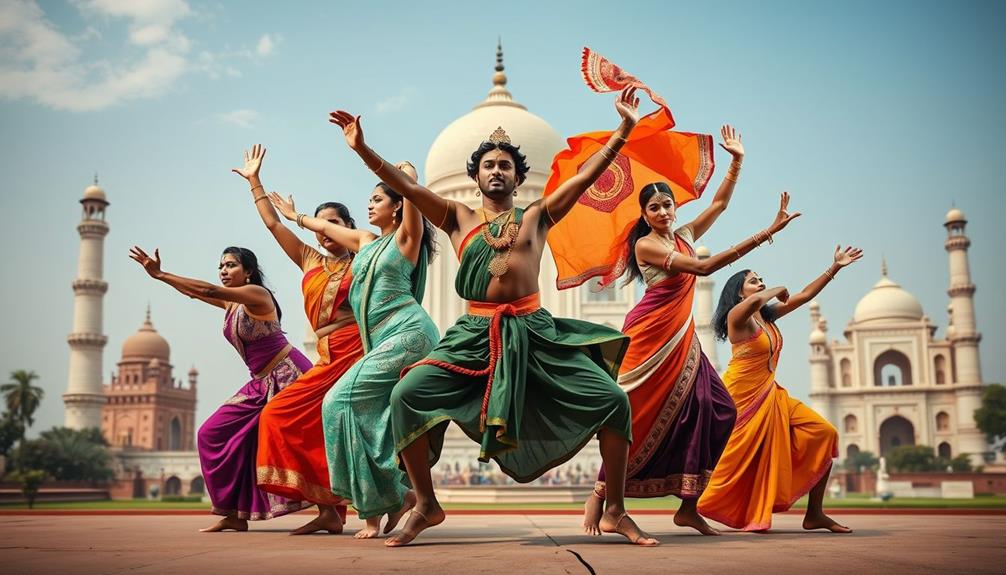
When you think about the pioneers of performance art in India, several influential artists come to mind, each contributing unique perspectives.
The evolution of this art form can be likened to the complexities seen in the dynamics of narcissist-codependent relationships, where artists often reflect societal struggles and personal narratives.
From Bhupen Khakhar's reflections on societal rituals to Mithu Sen's integration of media, these artists explore themes that resonate deeply in contemporary culture.
You'll see how their work not only shapes artistic expression but also impacts broader discussions within the art community.
Influential Pioneers' Contributions
Performance art in India has been profoundly shaped by a group of pioneering artists whose innovative approaches challenge societal norms and reflect cultural complexities. These influential pioneers have utilized their art to critique and explore various aspects of Indian society.
Here's a look at some of these remarkable artists:
| Artist | Contribution | Themes Explored |
|---|---|---|
| Bhupen Khakhar | Reflected societal rituals and governmental dynamics in post-Independence India. | Societal norms, identity |
| Nikhil Chopra | Developed immersive performances with his character Yog Raj Chitrakar. | Personal and national identity |
| Pushpamala N. | Created layered narratives through photo-performance. | Cultural identities |
| Ravi Agarwal | Addressed environmental pollution with the piece "Shroud." | Environmental awareness |
| Hema Upadhyay | Integrated mixed media with performance to provoke thought. | Audience expectations |
These artists not only redefine performance art but also engage audiences in deeper dialogues about identity, culture, and the pressing issues of our time. Their contributions continue to inspire and influence the evolution of performance art in India.
Notable Thematic Explorations
Exploring the transformative potential of performance art reveals a rich tapestry of themes that resonate with Indian society today. Pioneering artists like Nikhil Chopra use their work to investigate personal and national identity through his character, Yog Raj Chitrakar. This thematic exploration examines the intersections of self and society, inviting viewers to reflect on their own identities and engage in thought-provoking discussions about the nature of existence.
Pushpamala N. employs photo-performance to construct layered narratives that challenge traditional representations of gender and culture in India, prompting a re-evaluation of societal norms.
Similarly, Ravi Agarwal's impactful piece, "Shroud," confronts environmental pollution, particularly the contamination of the Yamuna River, highlighting urgent ecological concerns through his art forms.
Atul Bhalla investigates the cultural significance of water, creating installations that celebrate and critique its essential role in daily life.
Finally, Hema Upadhyay integrates performance into mixed media to confront societal expectations, expanding the dialogue around contemporary issues in India.
Each of these artists contributes to significant thematic explorations, showcasing how performance art can address personal, cultural, and environmental narratives, ultimately enriching the landscape of Indian contemporary art.
Impact on Contemporary Art
How have pioneering artists in performance art shaped contemporary practices in India? These trailblazers, like Bhupen Khakhar, Nikhil Chopra, and Pushpamala N., have infused personal narratives and cultural commentary into their works, transforming the landscape of contemporary art.
Their bold approaches invite you to reflect on societal issues, making performance art an essential medium for expression. The integration of performance art with AI-generated music has also opened new avenues for creativity and collaboration in contemporary practices.
Organizations like the Khoj International Artists Association have further propelled this evolution since 1997, fostering dialogue and innovative practices among artists. Ravi Agarwal's "Shroud" exemplifies this intersection, creatively tackling environmental pollution through performance art.
Similarly, Mithu Sen pushes boundaries by merging traditional media with performance, showcasing the fluidity of artistic expression.
As urban settings become the backdrop for performances, artists like Hema Upadhyay emphasize public engagement and participatory experiences. This shift underscores how contemporary art interacts with society, making it more accessible and relevant.
Through these pioneering efforts, performance art in India not only challenges conventions but also enriches the broader narrative of contemporary arts, encouraging you to engage with art in profound and meaningful ways.
Influential Performance Art Works
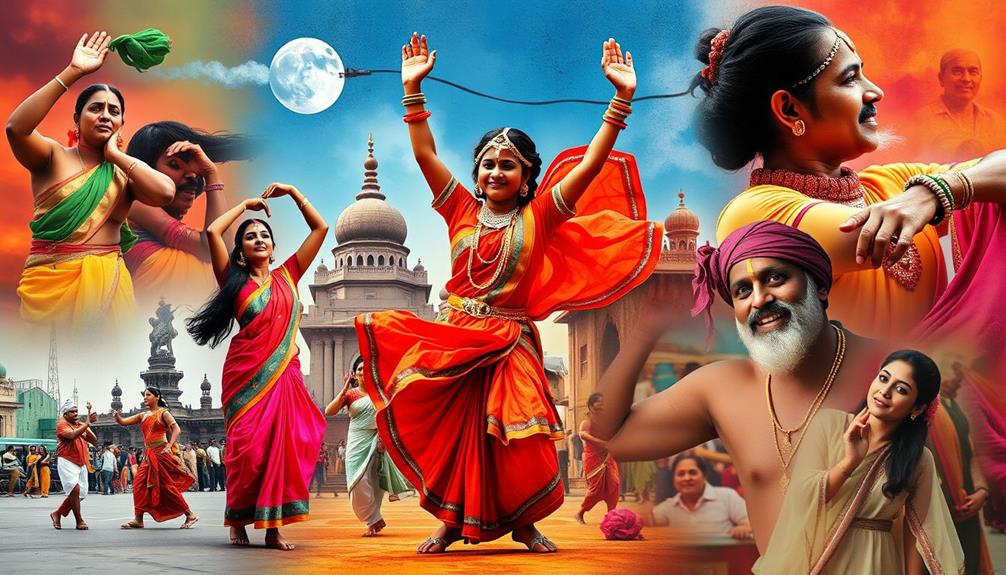
As you explore influential performance art works in India, you'll encounter Nikhil Chopra's unique character, Yog Raj Chitrakar, which powerfully examines personal and national identity.
Chopra's work resonates with the psychological benefits of engaging in art as a form of expression and reflection, akin to the importance of maintaining a healthy weight to manage one's well-being.
Additionally, the environmental themes in works like Ravi Agarwal's "Shroud" reveal the urgent issues surrounding pollution and our relationship with nature.
These pieces not only challenge perceptions but also provoke critical conversations about identity and the environment.
Nikhil Chopra's Identity Exploration
Nikhil Chopra's performance art captivates audiences by delving deep into the complexities of personal and national identity through his character, Yog Raj Chitrakar. This art form allows you to witness a profound exploration of how individual experiences intertwine with broader cultural narratives.
Chopra's performances aren't just visual spectacles; they're immersive experiences that invite you to engage with themes of memory and identity. Similar to how BPD-coded characters in media reflect intense emotional experiences, Chopra's work evokes a deep emotional response that resonates with viewers on multiple levels.
As he incorporates live drawing, storytelling, and traditional Indian art forms, you can see how he addresses contemporary issues, like globalization's impact on cultural identity. His performances often last several hours, creating a space for transformation—both in his physical appearance and the environment around him.
You'll notice how this duration fosters a connection between the artist and the audience, urging you to contemplate your perceptions of identity.
Chopra's use of various media, including photography and video, enriches the narratives he constructs. Each element challenges your understanding of artistic expression, prompting you to reflect on the layers of identity that shape us all.
Through Yog Raj Chitrakar, Chopra not only entertains but also educates, pushing you to confront the complexities of who you're within a collective identity.
Environmental Themes in Art
Environmental themes in performance art are increasingly resonating with audiences, drawing attention to the pressing ecological issues we face today. Artists like Ravi Agarwal use their work to highlight environmental degradation, as seen in his piece "Shroud," which addresses the pollution of the Yamuna River. This powerful performance underscores the impact of urban waterways on our health and environment.
Additionally, the incorporation of creative exploration in play can enhance children's understanding of ecological issues, fostering a generation that's more environmentally aware.
Atul Bhalla's installations dive deeper into the cultural significance of water in Indian society, skillfully exploring themes of scarcity and conservation. Mithu Sen takes it a step further by merging performance with visual art, creating interactive experiences that challenge you to engage with critical environmental issues.
Nikhil Chopra's character, Yog Raj Chitrakar, reflects on personal and national identity while tackling ecological balance and sustainability. These influential works not only entertain but also foster a much-needed dialogue about ecological awareness.
As the visibility of performance art focusing on environmental concerns grows, it encourages community involvement in conservation efforts. By attending these art and entertainment experiences, you can become part of a movement that champions awareness and action toward a healthier planet.
Key Themes in Performance Art
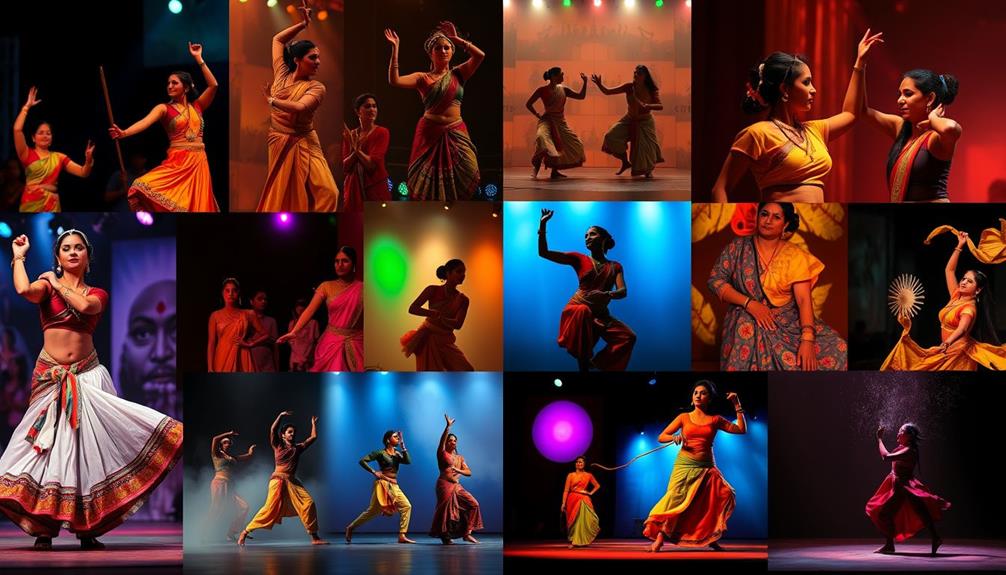
While exploring performance art in India, you'll find that key themes often intertwine with pressing social issues and cultural narratives. Identity plays an essential role, with artists like Nikhil Chopra using characters to explore personal and national identities. Feminist themes emerge prominently, challenging societal norms and examining women's experiences through innovative mediums.
Moreover, environmental concerns aren't neglected; artists like Ravi Agarwal address pollution, exemplified in his work "Shroud," which focuses on the Yamuna River. Rituals and mythology, particularly related to water, frequently appear, enriching the cultural context of these performances.
Here's a table that highlights these themes:
| Theme | Description |
|---|---|
| Identity | Exploration of personal and national identity |
| Feminist | Challenging societal norms and highlighting women's issues |
| Environmental | Addressing pollution and ecological concerns |
| Rituals & Mythology | Incorporating cultural narratives, especially around water |
| Humor & Interaction | Engaging audiences to foster community and dialogue |
These themes create a rich tapestry that reflects contemporary issues, making performance art a powerful medium for expression in India.
Cultural Significance of Performance Art
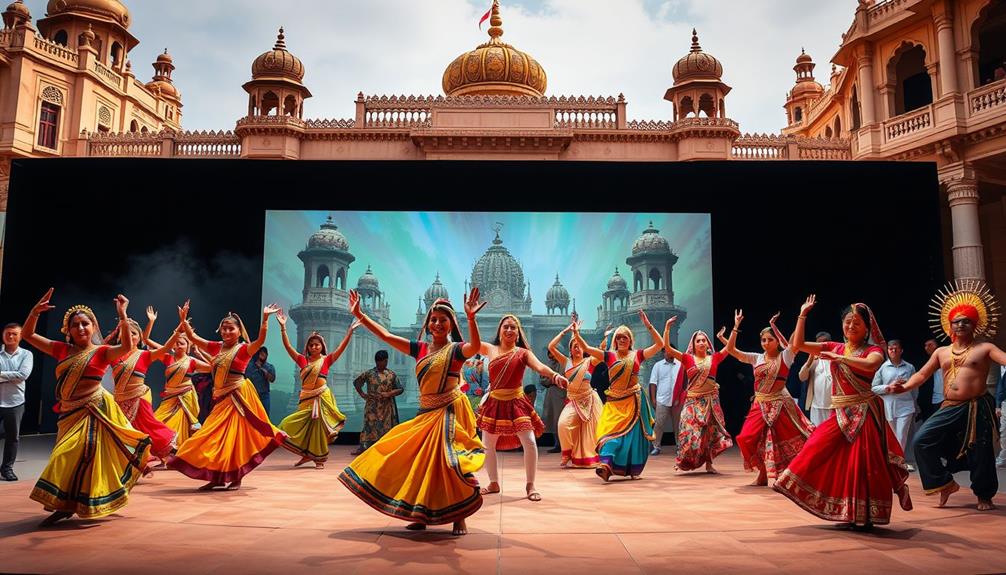
Performance art in India serves as a vibrant reflection of the country's rich cultural tapestry and evolving social landscape. The cultural significance of performance art lies in its ability to engage with a multitude of narratives, bridging the gap between tradition and contemporary expression.
Here are four key aspects of its importance:
- Cultural Narratives: It draws from traditional forms like Kathak and Jatra, preserving stories and rituals central to Indian identity, much like the way Aboriginal rock art serves as a historical record of life and beliefs.
- Community Engagement: Through public performances, it fosters dialogue around societal issues, encouraging community participation.
- Emotional Expression: Rooted in the Natya Shastra, performance art conveys emotions and community stories, highlighting the essence of nava rasa.
- Interplay with Religion: Often intertwining with religious practices, it serves as a means of worship, reinforcing cultural heritage.
Impact of Technology on Art
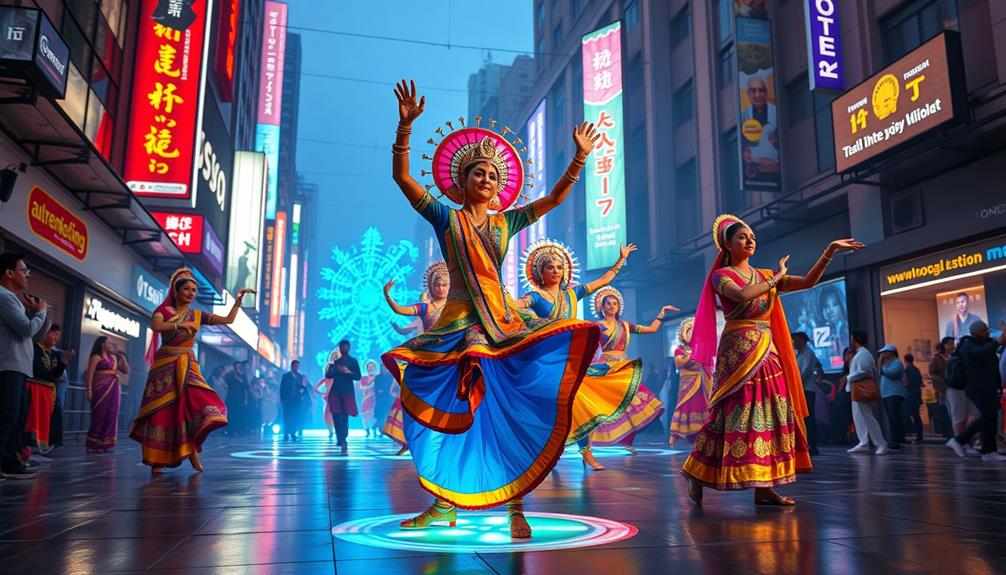
The evolution of performance art in India has been considerably influenced by technology, reshaping how artists create and connect with audiences. With the rise of digital platforms, you've seen Indian performance artists gaining global exposure, reaching wider audiences, and collaborating across cultural boundaries.
During the pandemic, many artists adopted virtual performances and online classes, leading to advanced forms of art that enhance audience engagement through interactive experiences. Additionally, the incorporation of AI in cybersecurity has provided artists with secure platforms to showcase their work without fear of data breaches.
Technology also facilitates the creation of immersive experiences in performance art. You might notice artists utilizing multimedia elements to challenge traditional viewing experiences and enrich narratives. The integration of social media has allowed communities to form around shared artistic interests, encouraging participation in events like Open Mic and Slam Poetry that leverage digital outreach.
Moreover, performative artists use technology to address contemporary issues such as pollution and societal narratives. This not only reshapes their artistic expressions but also promotes social awareness.
Evolution of Audience Engagement
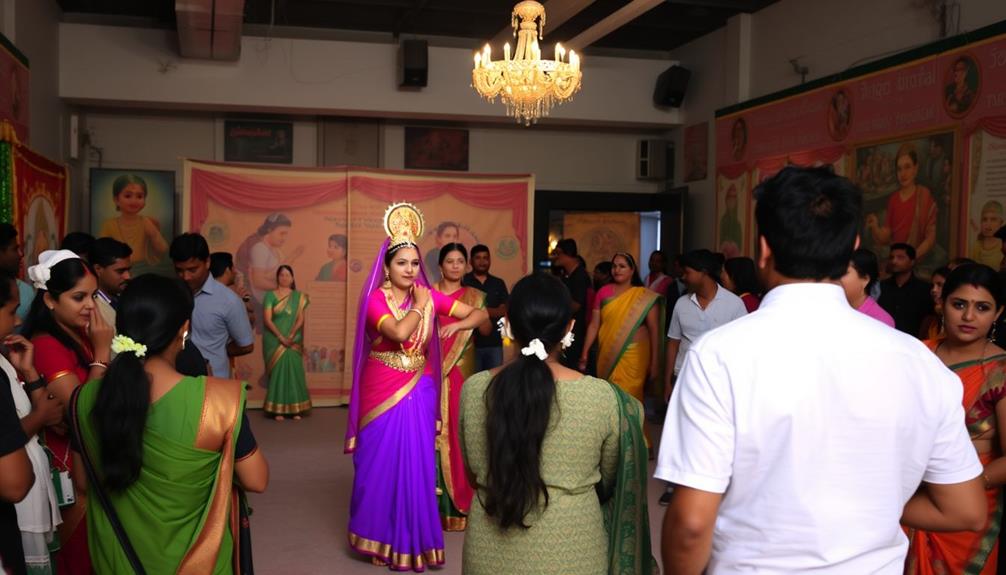
In recent years, audience engagement has transformed dramatically, shifting from mere observation to vibrant participation in performance art. This evolution has opened up a world of interactive experiences where you're no longer just a spectator; you're part of the performance itself.
With the rise of unique venues and immersive experiences, artists now create spaces where you can physically engage with the artwork. Here are some ways this engagement is unfolding:
- Interactive Installations: Artists now create spaces where you can physically engage with the artwork.
- Live Feedback: Performances often include real-time audience reactions, shaping the outcome of the piece.
- Community Involvement: Many artists address social issues, inviting you to participate and contribute to meaningful conversations.
- Public Engagement: Events like Mithu Sen's performances at India Gate demonstrate the power of humor and interaction, attracting diverse crowds.
With events like KhojLive08 highlighting these participatory approaches, the lines between artist and audience blur, allowing for deeper connections.
You'll find that the experience isn't just about watching; it's about being involved, fostering a sense of community and awareness. As performance art continues to evolve, your role in this dialogue becomes increasingly essential.
Contemporary Trends in Performance Art
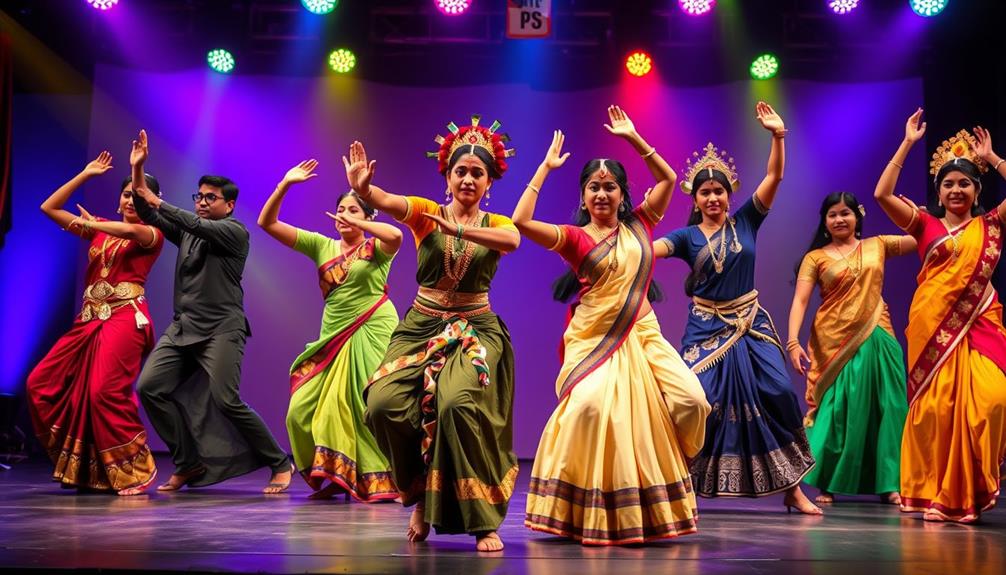
As audience engagement evolves, contemporary performance art in India reflects a dynamic interplay between traditional practices and modern influences. Artists are increasingly incorporating digital technology, utilizing virtual platforms and interactive elements to enhance audience participation. For instance, Mithu Sen blurs the boundaries between traditional and contemporary media, merging performance with photography and video to create immersive experiences that challenge conventional viewing.
Environmental themes also take center stage in contemporary works. Ravi Agarwal's "Shroud" powerfully addresses pollution in the Yamuna River, raising awareness about ecological concerns. Additionally, public engagement initiatives, such as Hema Upadhyay's mixed media performances, foster community participation and encourage dialogue on pressing social issues.
The Khoj International Artists Association, founded in 1997, plays an essential role in promoting these experimental art practices, supporting both Indian and international artists in their exploration of contemporary themes.
| Artist | Key Work | Theme |
|---|---|---|
| Mithu Sen | Performance Art | Media Integration |
| Ravi Agarwal | Shroud | Environmental Issues |
| Hema Upadhyay | Mixed Media | Community Engagement |
| Khoj | Various Artists | Experimental Practices |
| Contemporary | Diverse Themes | Blending Tradition |
Performance Art and Social Issues
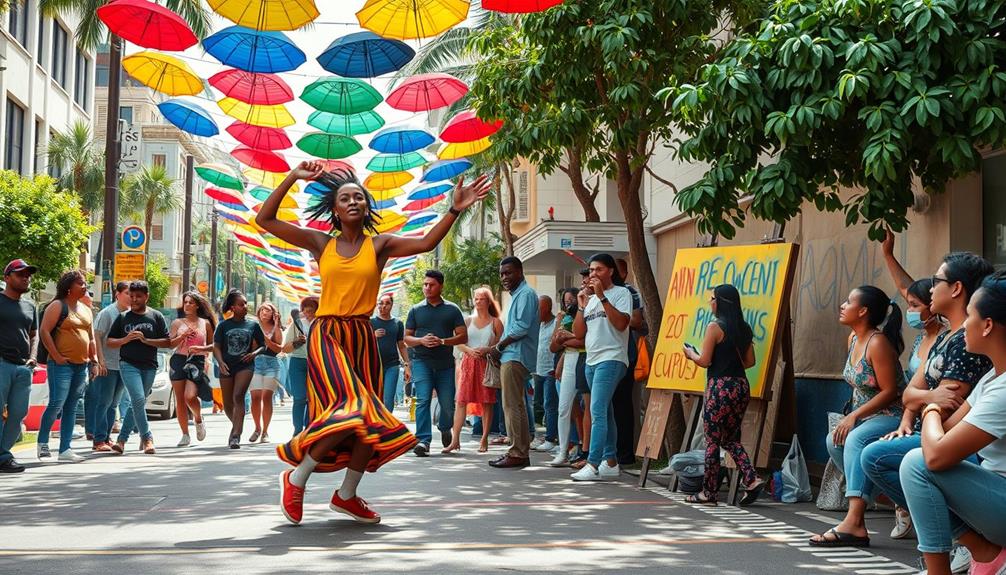
Performance art in India is a powerful tool for addressing pressing social issues, especially environmental awareness and identity challenges.
You'll see artists like Ravi Agarwal spotlighting pollution in the Yamuna River, while others explore migration and personal narratives, reflecting the complexities of modern life.
These performances not only engage audiences but also spark vital conversations about our society's most urgent topics.
Environmental Awareness Through Art
Through the lens of performance art, artists in India are tackling urgent environmental issues, from pollution to water conservation. They use their craft to spark conversations and inspire change. Here are a few ways artists are making an impact:
- Highlighting Pollution: Ravi Agarwal's installations focus on the pollution of the Yamuna River, presenting a stark visual narrative.
- Water Conservation: Atul Bhalla's use of installations and photographs engages audiences in discussions about the cultural significance of water and environmental stewardship.
- Community Engagement: Many performances incorporate participatory elements, encouraging you and your community to join the dialogue on environmental challenges.
- Humor and Critique: Artists blend humor with critical commentary, prompting you to reflect on your relationship with nature and public spaces.
These performances often occur in urban settings, aiming to inspire collective action and foster a sense of responsibility toward ecological preservation.
Identity and Migration Themes
What happens when personal stories of migration intersect with the broader themes of identity in art? You witness a powerful exploration of the human experience. Performance art in India increasingly captures these intersections, revealing the complexities of identity shaped by migration. Artists like Nikhil Chopra use character-driven narratives to reflect on individual and national identities, while Pushpamala N. employs photo-performance to shed light on migrants' challenges.
Ravi Agarwal's "Shroud" intertwines environmental issues with identity, illustrating the impact of urban migration on cultural significance. Additionally, feminist themes emerge as artists challenge traditional gender roles, amplifying women's experiences amid migration.
Here's a glimpse into how different artists approach identity and migration themes:
| Artist | Medium | Focus Area |
|---|---|---|
| Nikhil Chopra | Performance | Personal vs. National Identity |
| Pushpamala N. | Photo-Performance | Cultural Narratives & Migration |
| Ravi Agarwal | Installation | Environmental Impact & Identity |
| Various Artists | Live Performance | Feminist Perspectives on Migration |
| Collaborative Works | Multidisciplinary | Collective Experiences of Displacement |
Through these expressions, you see the profound narrative of migration and identity unfold.
Future Directions for Performance Art
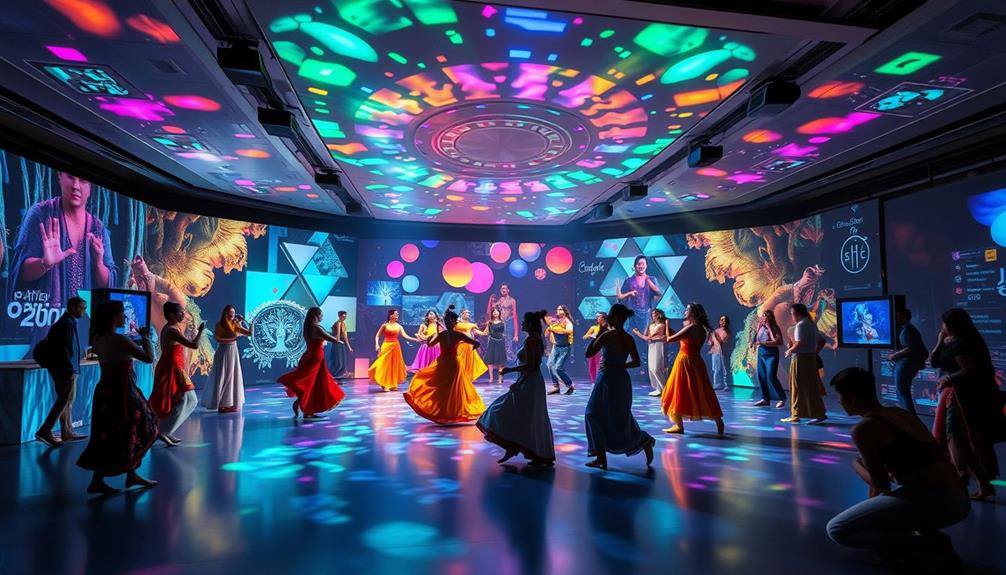
As we look ahead, the future of performance art in India is poised for an exciting transformation. You'll witness a blend of advanced techniques and innovative ideas reshaping the landscape. Here are four future directions you can expect:
- Technology Integration: Artists are likely to harness technology for interactive and immersive experiences that deeply engage audiences.
- Diverse Mediums: Emerging artists will explore fusion styles, merging traditional performance art with contemporary themes and pressing societal issues.
- Collaborative Projects: Expect collaborations among artists from various disciplines, enriching storytelling and reflecting a wider spectrum of societal narratives.
- Digital Platforms: The rise of digital platforms will enhance visibility for performance artists, providing global exposure and access to new markets.
This evolution points toward an emphasis on social impact, as artists increasingly tackle urgent issues and foster community engagement through their work.
The future directions of performance art in India promise not only growth but also a profound connection to cultural dialogues, ensuring that the art form remains vibrant and relevant in an ever-changing world.
Frequently Asked Questions
What Is the Origin of Performing Arts in India?
The origin of performing arts in India lies in ancient texts like the Natya Shastra and Vedic literature. These traditions, intertwined with religion, shaped dance and music, reflecting local stories and cultural expressions throughout history.
How Have Performing Arts Changed Over Time?
You'd think performing arts just dance around unchanged, right? But over time, they've morphed dramatically, blending tradition with modernity, tackling pressing issues, and using technology to connect like never before—who knew art could adapt so well?
What Is the History of Performance Art?
You'll find performance art has a rich history, evolving from early rituals and theater to contemporary expressions. It challenges norms, engages audiences, and reflects societal issues, making it a dynamic and transformative art form.
What Is the History of Indian Art?
Indian art's history is a breathtaking tapestry, woven with ancient texts and vibrant traditions. You'll find it evolving through centuries, influenced by regional flair and colonial echoes, shaping a unique narrative that's both rich and dynamic.
Conclusion
To sum up, performance art in India has evolved like a river carving its way through the landscape, shaping and reshaping cultural identities. From its historical roots to contemporary expressions, it reflects the complexities of society and engages audiences in unique ways. As you explore this vibrant art form, you'll witness its power to challenge norms and provoke thought. The future of performance art promises to be just as dynamic, inviting new voices to join the conversation.
